Management Accounting Report: Ever Joy Enterprises (UK) - Finance
VerifiedAdded on 2020/10/05
|24
|4759
|301
Report
AI Summary
This report offers a comprehensive analysis of management accounting principles, specifically tailored for Ever Joy Enterprises (UK). It begins with an introduction to management accounting, differentiating it from financial accounting, and exploring various management accounting systems such as cost accounting, inventory management, and job costing. The report details different types of management accounting reports and their significance for the organization. Furthermore, it delves into break-even point calculations, providing insights into profitability and ticket sales. Budgeting is evaluated as a planning tool, along with the importance of strong financial governance in preventing financial issues and ensuring sustainable success. The report provides valuable insights into the application of management accounting within a leisure and entertainment context.
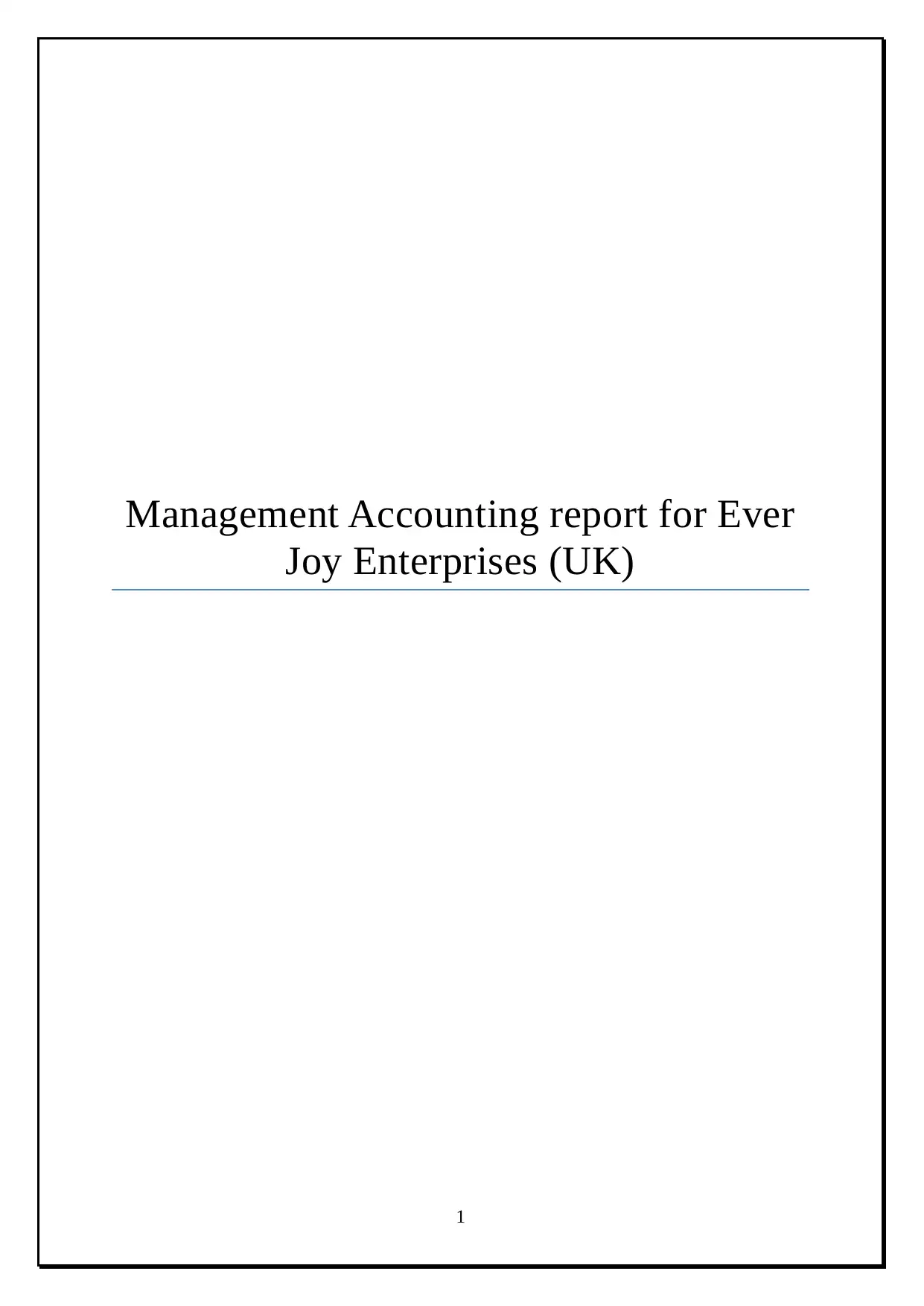
Management Accounting report for Ever
Joy Enterprises (UK)
1
Joy Enterprises (UK)
1
Paraphrase This Document
Need a fresh take? Get an instant paraphrase of this document with our AI Paraphraser
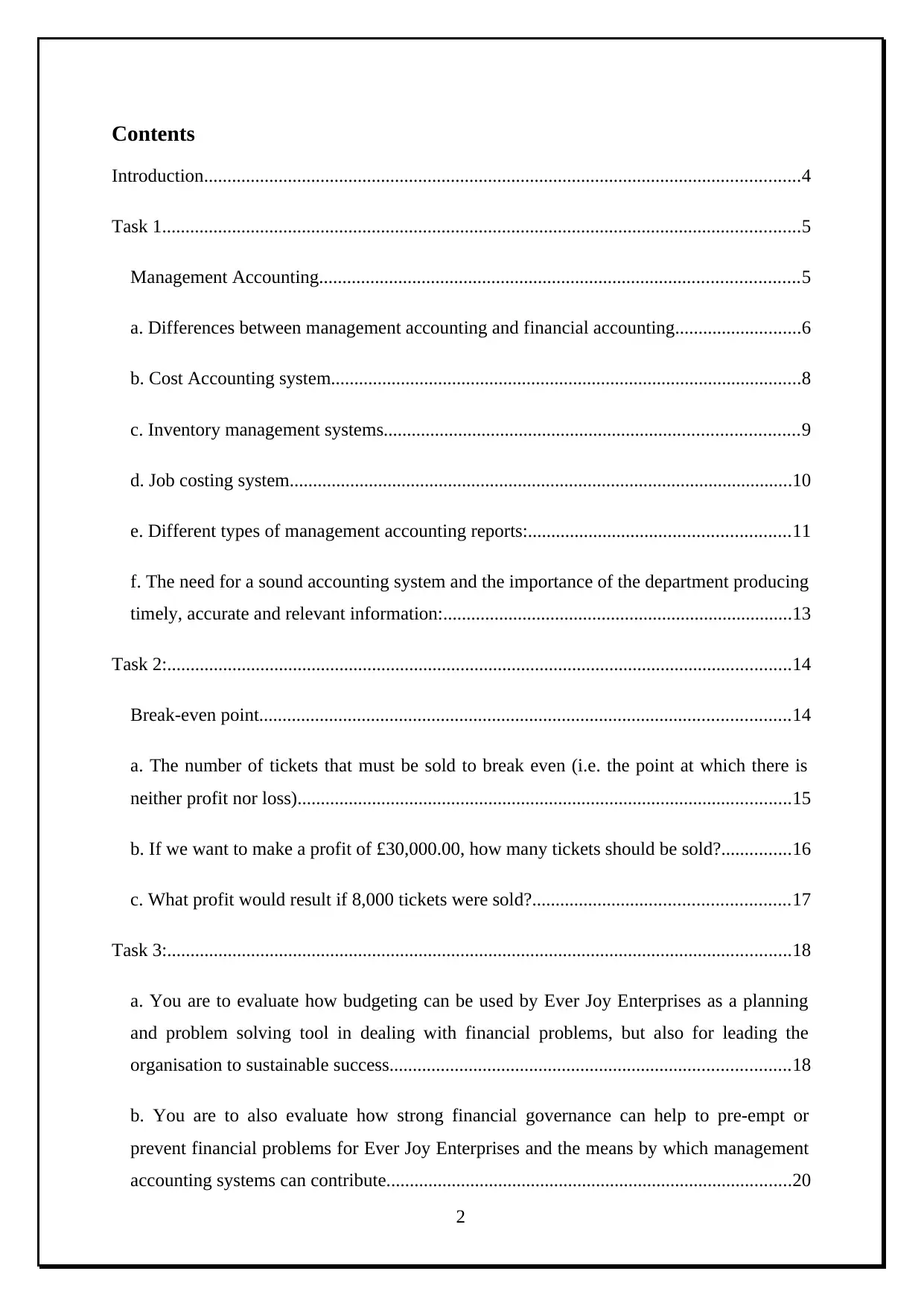
Contents
Introduction................................................................................................................................4
Task 1.........................................................................................................................................5
Management Accounting.......................................................................................................5
a. Differences between management accounting and financial accounting...........................6
b. Cost Accounting system.....................................................................................................8
c. Inventory management systems.........................................................................................9
d. Job costing system............................................................................................................10
e. Different types of management accounting reports:........................................................11
f. The need for a sound accounting system and the importance of the department producing
timely, accurate and relevant information:...........................................................................13
Task 2:......................................................................................................................................14
Break-even point..................................................................................................................14
a. The number of tickets that must be sold to break even (i.e. the point at which there is
neither profit nor loss)..........................................................................................................15
b. If we want to make a profit of £30,000.00, how many tickets should be sold?...............16
c. What profit would result if 8,000 tickets were sold?.......................................................17
Task 3:......................................................................................................................................18
a. You are to evaluate how budgeting can be used by Ever Joy Enterprises as a planning
and problem solving tool in dealing with financial problems, but also for leading the
organisation to sustainable success......................................................................................18
b. You are to also evaluate how strong financial governance can help to pre-empt or
prevent financial problems for Ever Joy Enterprises and the means by which management
accounting systems can contribute.......................................................................................20
2
Introduction................................................................................................................................4
Task 1.........................................................................................................................................5
Management Accounting.......................................................................................................5
a. Differences between management accounting and financial accounting...........................6
b. Cost Accounting system.....................................................................................................8
c. Inventory management systems.........................................................................................9
d. Job costing system............................................................................................................10
e. Different types of management accounting reports:........................................................11
f. The need for a sound accounting system and the importance of the department producing
timely, accurate and relevant information:...........................................................................13
Task 2:......................................................................................................................................14
Break-even point..................................................................................................................14
a. The number of tickets that must be sold to break even (i.e. the point at which there is
neither profit nor loss)..........................................................................................................15
b. If we want to make a profit of £30,000.00, how many tickets should be sold?...............16
c. What profit would result if 8,000 tickets were sold?.......................................................17
Task 3:......................................................................................................................................18
a. You are to evaluate how budgeting can be used by Ever Joy Enterprises as a planning
and problem solving tool in dealing with financial problems, but also for leading the
organisation to sustainable success......................................................................................18
b. You are to also evaluate how strong financial governance can help to pre-empt or
prevent financial problems for Ever Joy Enterprises and the means by which management
accounting systems can contribute.......................................................................................20
2
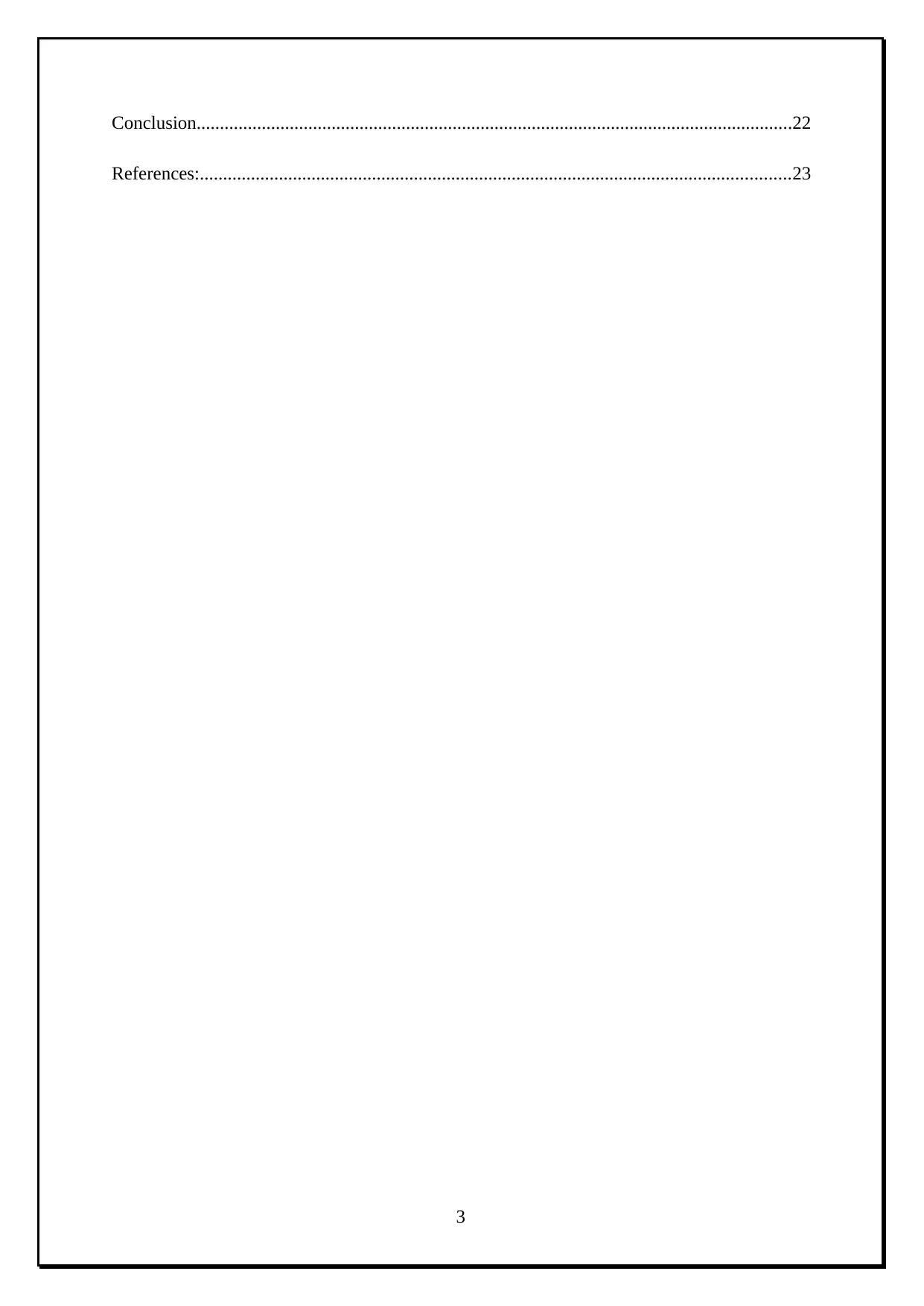
Conclusion................................................................................................................................22
References:...............................................................................................................................23
3
References:...............................................................................................................................23
3
⊘ This is a preview!⊘
Do you want full access?
Subscribe today to unlock all pages.

Trusted by 1+ million students worldwide
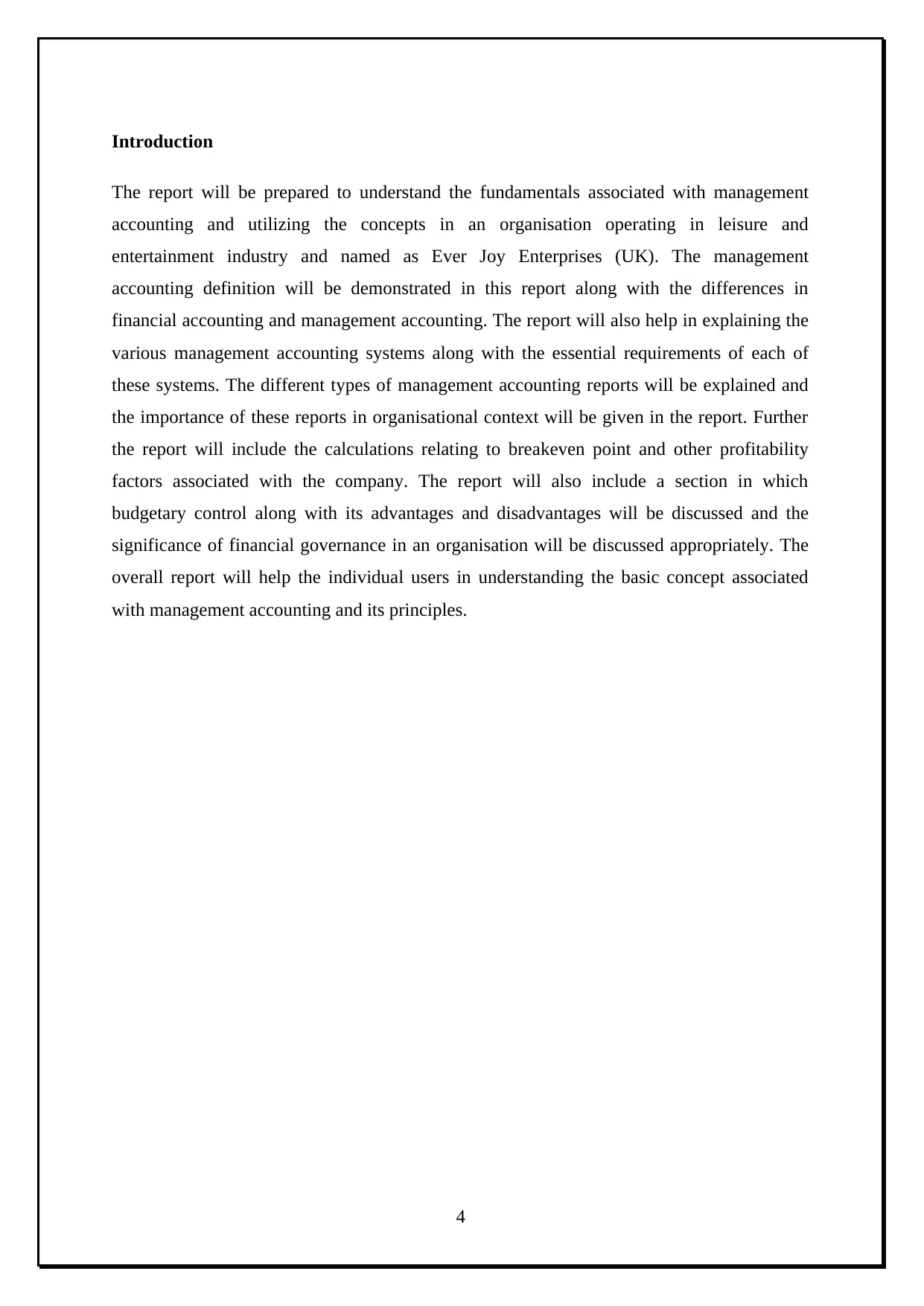
Introduction
The report will be prepared to understand the fundamentals associated with management
accounting and utilizing the concepts in an organisation operating in leisure and
entertainment industry and named as Ever Joy Enterprises (UK). The management
accounting definition will be demonstrated in this report along with the differences in
financial accounting and management accounting. The report will also help in explaining the
various management accounting systems along with the essential requirements of each of
these systems. The different types of management accounting reports will be explained and
the importance of these reports in organisational context will be given in the report. Further
the report will include the calculations relating to breakeven point and other profitability
factors associated with the company. The report will also include a section in which
budgetary control along with its advantages and disadvantages will be discussed and the
significance of financial governance in an organisation will be discussed appropriately. The
overall report will help the individual users in understanding the basic concept associated
with management accounting and its principles.
4
The report will be prepared to understand the fundamentals associated with management
accounting and utilizing the concepts in an organisation operating in leisure and
entertainment industry and named as Ever Joy Enterprises (UK). The management
accounting definition will be demonstrated in this report along with the differences in
financial accounting and management accounting. The report will also help in explaining the
various management accounting systems along with the essential requirements of each of
these systems. The different types of management accounting reports will be explained and
the importance of these reports in organisational context will be given in the report. Further
the report will include the calculations relating to breakeven point and other profitability
factors associated with the company. The report will also include a section in which
budgetary control along with its advantages and disadvantages will be discussed and the
significance of financial governance in an organisation will be discussed appropriately. The
overall report will help the individual users in understanding the basic concept associated
with management accounting and its principles.
4
Paraphrase This Document
Need a fresh take? Get an instant paraphrase of this document with our AI Paraphraser
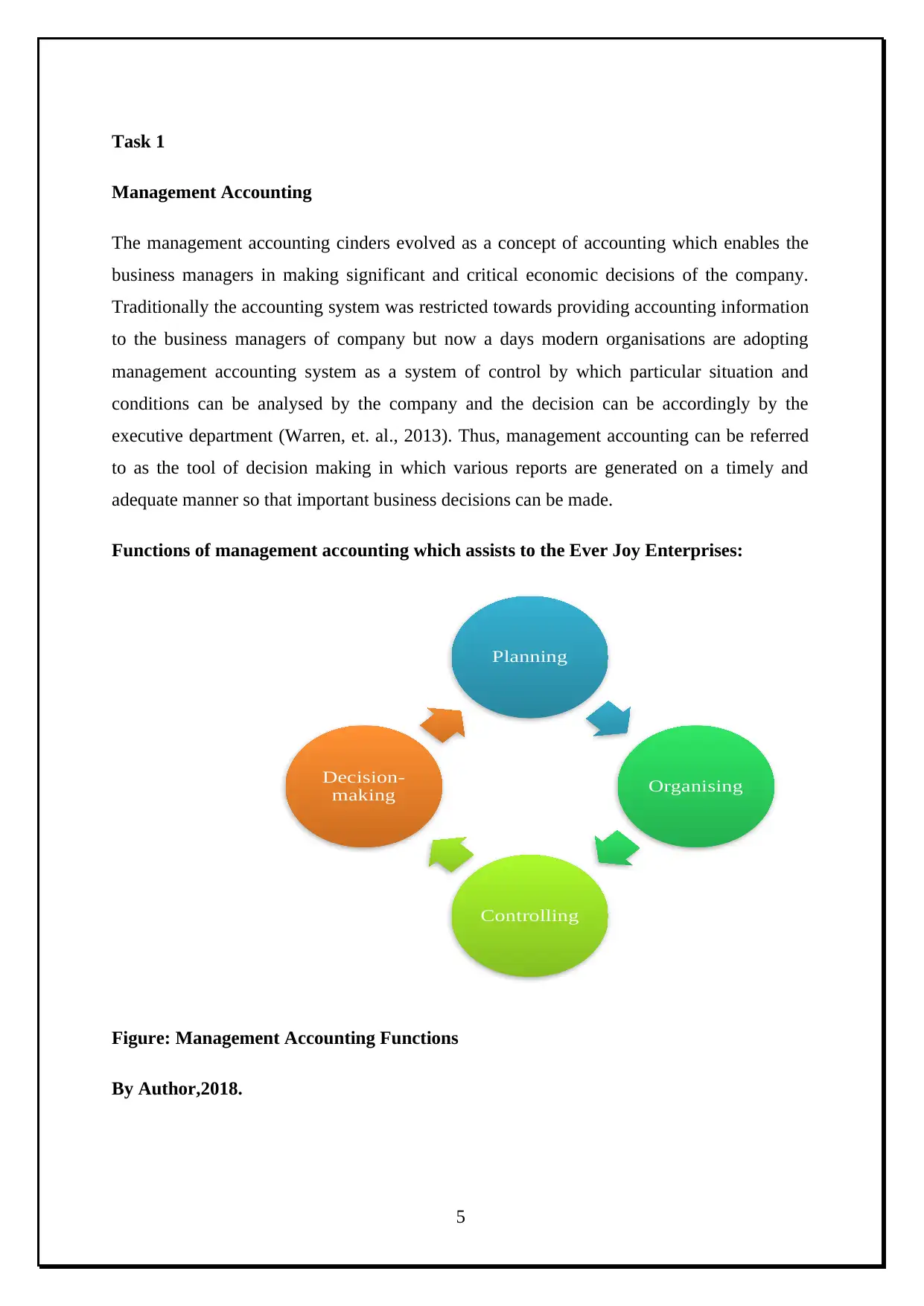
Task 1
Management Accounting
The management accounting cinders evolved as a concept of accounting which enables the
business managers in making significant and critical economic decisions of the company.
Traditionally the accounting system was restricted towards providing accounting information
to the business managers of company but now a days modern organisations are adopting
management accounting system as a system of control by which particular situation and
conditions can be analysed by the company and the decision can be accordingly by the
executive department (Warren, et. al., 2013). Thus, management accounting can be referred
to as the tool of decision making in which various reports are generated on a timely and
adequate manner so that important business decisions can be made.
Functions of management accounting which assists to the Ever Joy Enterprises:
Figure: Management Accounting Functions
By Author,2018.
5
Planning
Organising
Controlling
Decision-
making
Management Accounting
The management accounting cinders evolved as a concept of accounting which enables the
business managers in making significant and critical economic decisions of the company.
Traditionally the accounting system was restricted towards providing accounting information
to the business managers of company but now a days modern organisations are adopting
management accounting system as a system of control by which particular situation and
conditions can be analysed by the company and the decision can be accordingly by the
executive department (Warren, et. al., 2013). Thus, management accounting can be referred
to as the tool of decision making in which various reports are generated on a timely and
adequate manner so that important business decisions can be made.
Functions of management accounting which assists to the Ever Joy Enterprises:
Figure: Management Accounting Functions
By Author,2018.
5
Planning
Organising
Controlling
Decision-
making
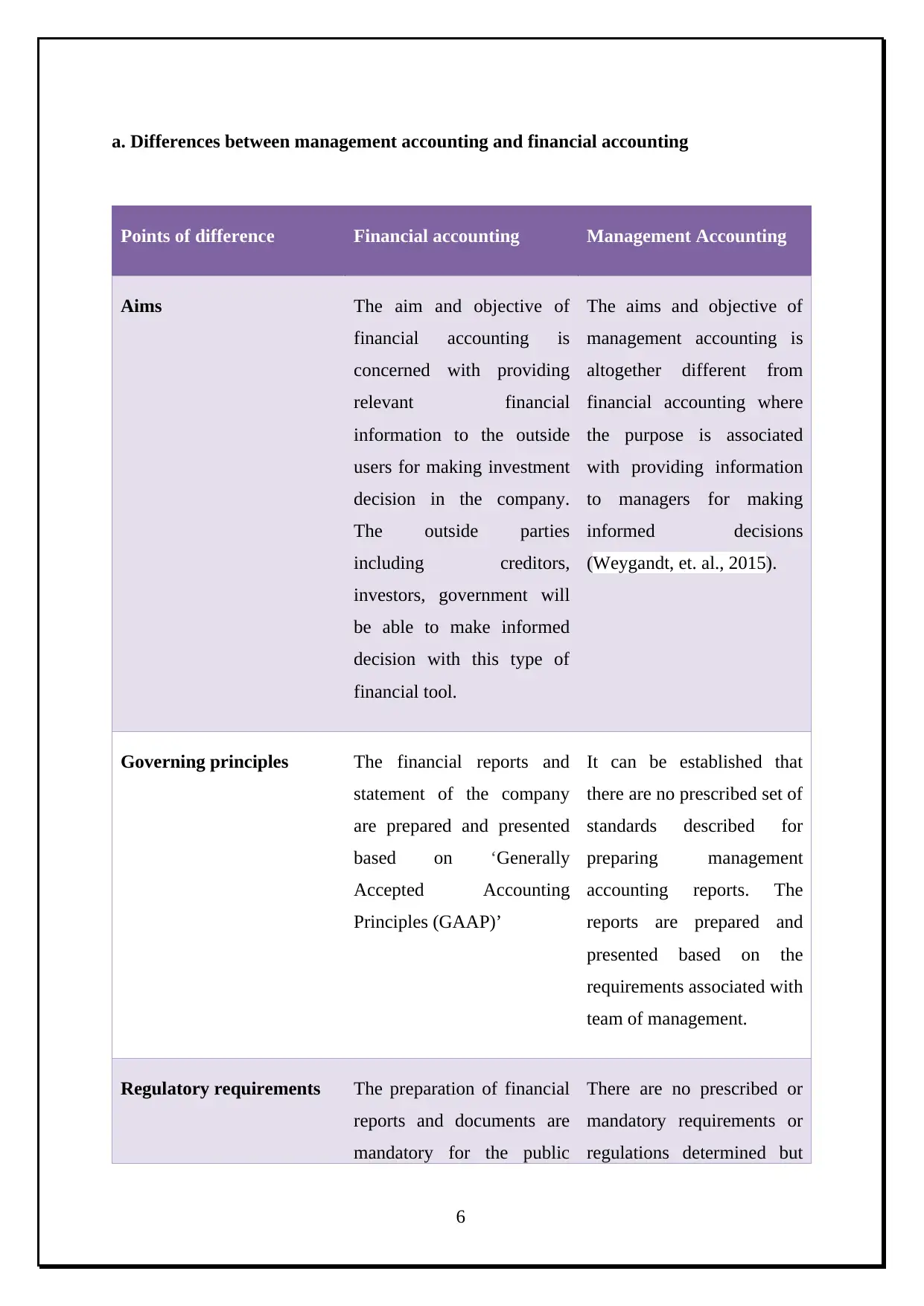
a. Differences between management accounting and financial accounting
Points of difference Financial accounting Management Accounting
Aims The aim and objective of
financial accounting is
concerned with providing
relevant financial
information to the outside
users for making investment
decision in the company.
The outside parties
including creditors,
investors, government will
be able to make informed
decision with this type of
financial tool.
The aims and objective of
management accounting is
altogether different from
financial accounting where
the purpose is associated
with providing information
to managers for making
informed decisions
(Weygandt, et. al., 2015).
Governing principles The financial reports and
statement of the company
are prepared and presented
based on ‘Generally
Accepted Accounting
Principles (GAAP)’
It can be established that
there are no prescribed set of
standards described for
preparing management
accounting reports. The
reports are prepared and
presented based on the
requirements associated with
team of management.
Regulatory requirements The preparation of financial
reports and documents are
mandatory for the public
There are no prescribed or
mandatory requirements or
regulations determined but
6
Points of difference Financial accounting Management Accounting
Aims The aim and objective of
financial accounting is
concerned with providing
relevant financial
information to the outside
users for making investment
decision in the company.
The outside parties
including creditors,
investors, government will
be able to make informed
decision with this type of
financial tool.
The aims and objective of
management accounting is
altogether different from
financial accounting where
the purpose is associated
with providing information
to managers for making
informed decisions
(Weygandt, et. al., 2015).
Governing principles The financial reports and
statement of the company
are prepared and presented
based on ‘Generally
Accepted Accounting
Principles (GAAP)’
It can be established that
there are no prescribed set of
standards described for
preparing management
accounting reports. The
reports are prepared and
presented based on the
requirements associated with
team of management.
Regulatory requirements The preparation of financial
reports and documents are
mandatory for the public
There are no prescribed or
mandatory requirements or
regulations determined but
6
⊘ This is a preview!⊘
Do you want full access?
Subscribe today to unlock all pages.

Trusted by 1+ million students worldwide
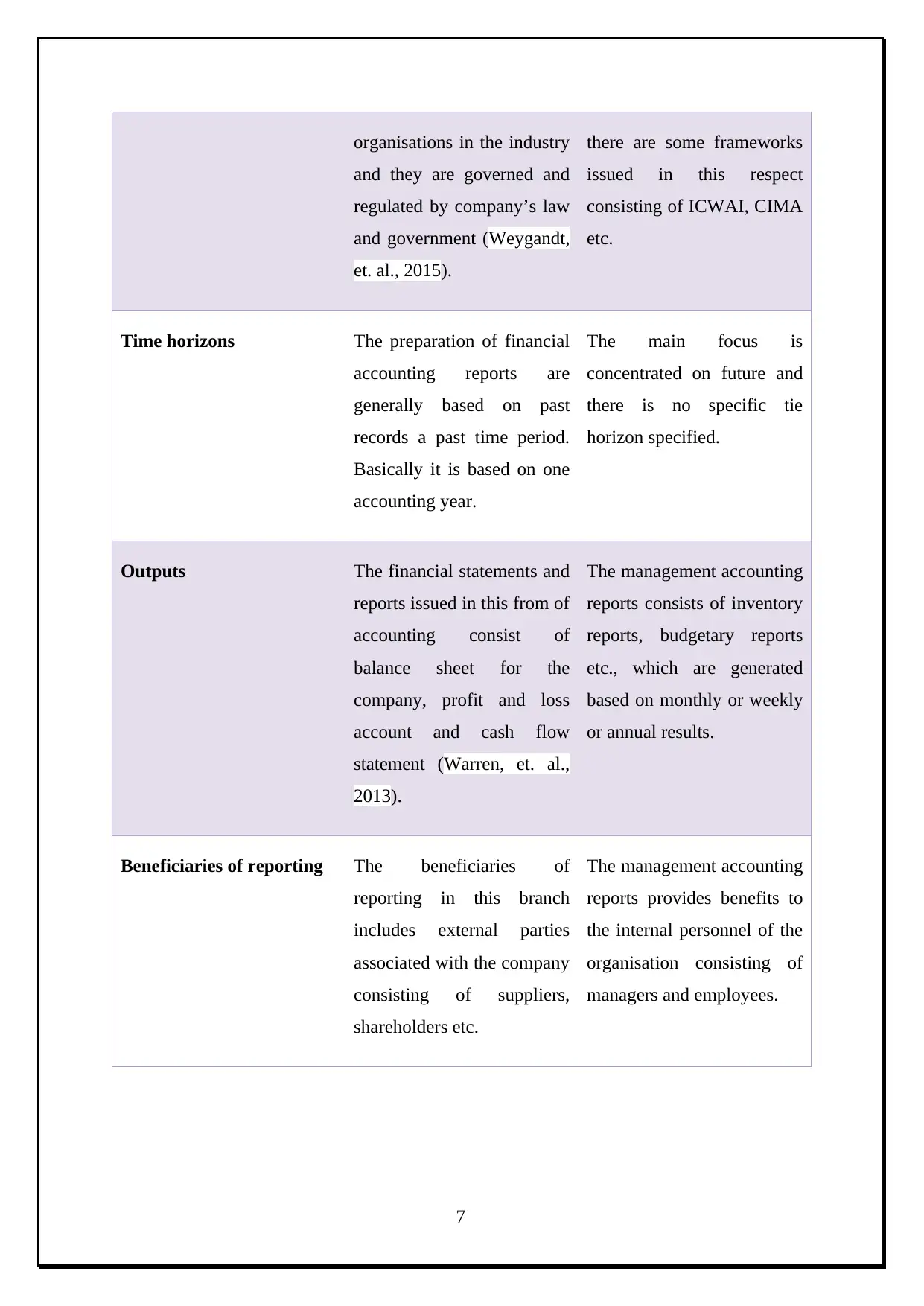
organisations in the industry
and they are governed and
regulated by company’s law
and government (Weygandt,
et. al., 2015).
there are some frameworks
issued in this respect
consisting of ICWAI, CIMA
etc.
Time horizons The preparation of financial
accounting reports are
generally based on past
records a past time period.
Basically it is based on one
accounting year.
The main focus is
concentrated on future and
there is no specific tie
horizon specified.
Outputs The financial statements and
reports issued in this from of
accounting consist of
balance sheet for the
company, profit and loss
account and cash flow
statement (Warren, et. al.,
2013).
The management accounting
reports consists of inventory
reports, budgetary reports
etc., which are generated
based on monthly or weekly
or annual results.
Beneficiaries of reporting The beneficiaries of
reporting in this branch
includes external parties
associated with the company
consisting of suppliers,
shareholders etc.
The management accounting
reports provides benefits to
the internal personnel of the
organisation consisting of
managers and employees.
7
and they are governed and
regulated by company’s law
and government (Weygandt,
et. al., 2015).
there are some frameworks
issued in this respect
consisting of ICWAI, CIMA
etc.
Time horizons The preparation of financial
accounting reports are
generally based on past
records a past time period.
Basically it is based on one
accounting year.
The main focus is
concentrated on future and
there is no specific tie
horizon specified.
Outputs The financial statements and
reports issued in this from of
accounting consist of
balance sheet for the
company, profit and loss
account and cash flow
statement (Warren, et. al.,
2013).
The management accounting
reports consists of inventory
reports, budgetary reports
etc., which are generated
based on monthly or weekly
or annual results.
Beneficiaries of reporting The beneficiaries of
reporting in this branch
includes external parties
associated with the company
consisting of suppliers,
shareholders etc.
The management accounting
reports provides benefits to
the internal personnel of the
organisation consisting of
managers and employees.
7
Paraphrase This Document
Need a fresh take? Get an instant paraphrase of this document with our AI Paraphraser
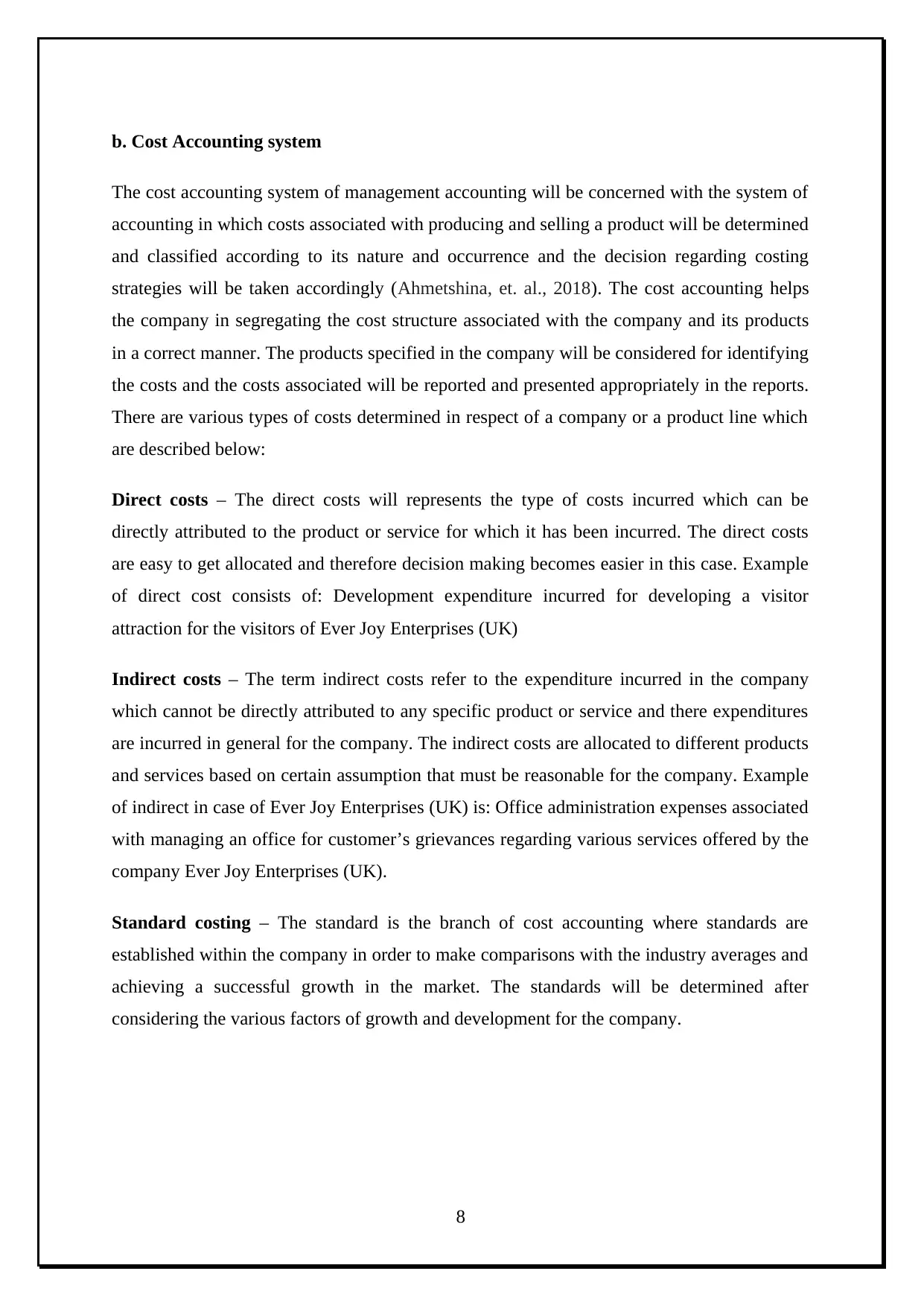
b. Cost Accounting system
The cost accounting system of management accounting will be concerned with the system of
accounting in which costs associated with producing and selling a product will be determined
and classified according to its nature and occurrence and the decision regarding costing
strategies will be taken accordingly (Ahmetshina, et. al., 2018). The cost accounting helps
the company in segregating the cost structure associated with the company and its products
in a correct manner. The products specified in the company will be considered for identifying
the costs and the costs associated will be reported and presented appropriately in the reports.
There are various types of costs determined in respect of a company or a product line which
are described below:
Direct costs – The direct costs will represents the type of costs incurred which can be
directly attributed to the product or service for which it has been incurred. The direct costs
are easy to get allocated and therefore decision making becomes easier in this case. Example
of direct cost consists of: Development expenditure incurred for developing a visitor
attraction for the visitors of Ever Joy Enterprises (UK)
Indirect costs – The term indirect costs refer to the expenditure incurred in the company
which cannot be directly attributed to any specific product or service and there expenditures
are incurred in general for the company. The indirect costs are allocated to different products
and services based on certain assumption that must be reasonable for the company. Example
of indirect in case of Ever Joy Enterprises (UK) is: Office administration expenses associated
with managing an office for customer’s grievances regarding various services offered by the
company Ever Joy Enterprises (UK).
Standard costing – The standard is the branch of cost accounting where standards are
established within the company in order to make comparisons with the industry averages and
achieving a successful growth in the market. The standards will be determined after
considering the various factors of growth and development for the company.
8
The cost accounting system of management accounting will be concerned with the system of
accounting in which costs associated with producing and selling a product will be determined
and classified according to its nature and occurrence and the decision regarding costing
strategies will be taken accordingly (Ahmetshina, et. al., 2018). The cost accounting helps
the company in segregating the cost structure associated with the company and its products
in a correct manner. The products specified in the company will be considered for identifying
the costs and the costs associated will be reported and presented appropriately in the reports.
There are various types of costs determined in respect of a company or a product line which
are described below:
Direct costs – The direct costs will represents the type of costs incurred which can be
directly attributed to the product or service for which it has been incurred. The direct costs
are easy to get allocated and therefore decision making becomes easier in this case. Example
of direct cost consists of: Development expenditure incurred for developing a visitor
attraction for the visitors of Ever Joy Enterprises (UK)
Indirect costs – The term indirect costs refer to the expenditure incurred in the company
which cannot be directly attributed to any specific product or service and there expenditures
are incurred in general for the company. The indirect costs are allocated to different products
and services based on certain assumption that must be reasonable for the company. Example
of indirect in case of Ever Joy Enterprises (UK) is: Office administration expenses associated
with managing an office for customer’s grievances regarding various services offered by the
company Ever Joy Enterprises (UK).
Standard costing – The standard is the branch of cost accounting where standards are
established within the company in order to make comparisons with the industry averages and
achieving a successful growth in the market. The standards will be determined after
considering the various factors of growth and development for the company.
8
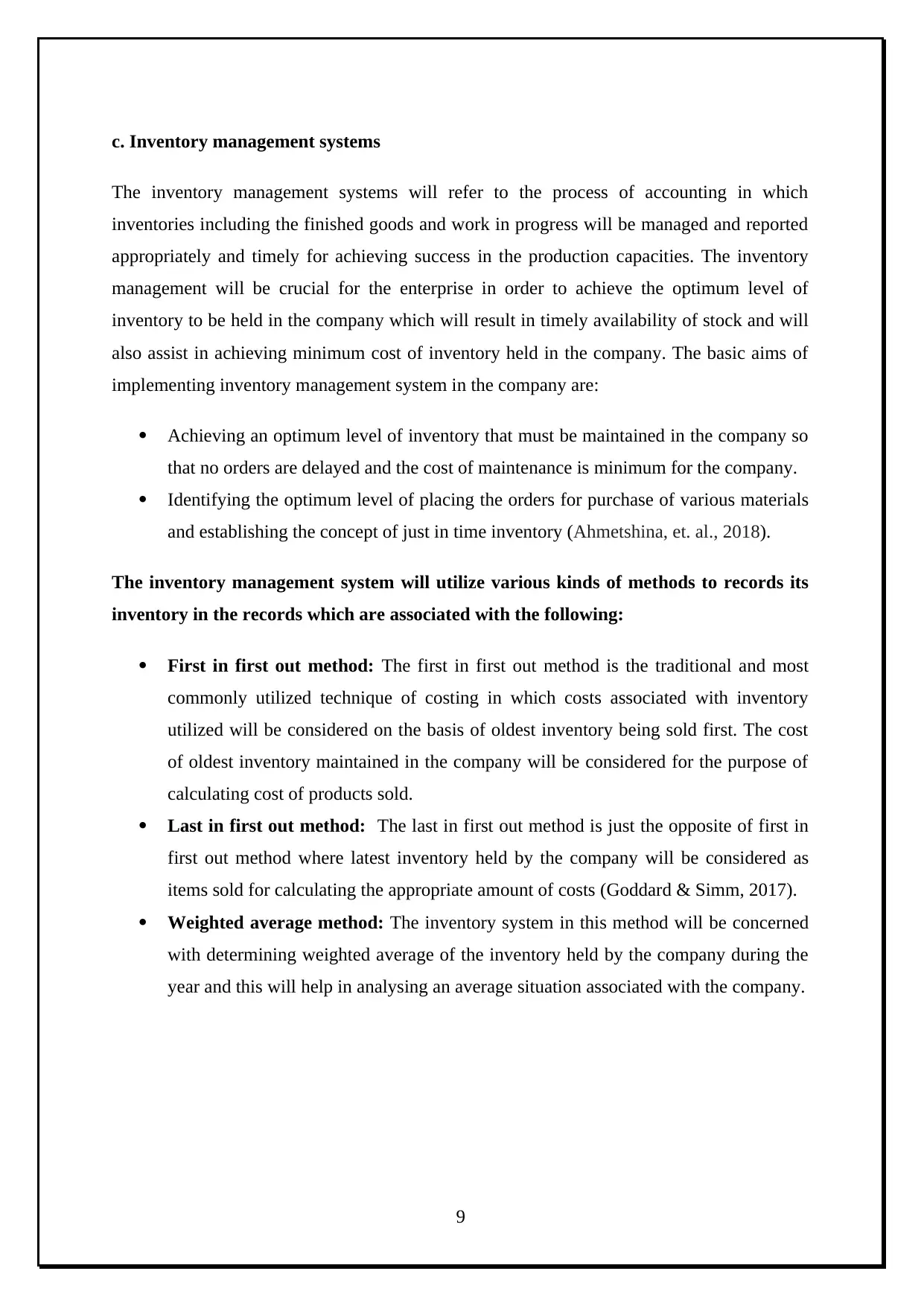
c. Inventory management systems
The inventory management systems will refer to the process of accounting in which
inventories including the finished goods and work in progress will be managed and reported
appropriately and timely for achieving success in the production capacities. The inventory
management will be crucial for the enterprise in order to achieve the optimum level of
inventory to be held in the company which will result in timely availability of stock and will
also assist in achieving minimum cost of inventory held in the company. The basic aims of
implementing inventory management system in the company are:
Achieving an optimum level of inventory that must be maintained in the company so
that no orders are delayed and the cost of maintenance is minimum for the company.
Identifying the optimum level of placing the orders for purchase of various materials
and establishing the concept of just in time inventory (Ahmetshina, et. al., 2018).
The inventory management system will utilize various kinds of methods to records its
inventory in the records which are associated with the following:
First in first out method: The first in first out method is the traditional and most
commonly utilized technique of costing in which costs associated with inventory
utilized will be considered on the basis of oldest inventory being sold first. The cost
of oldest inventory maintained in the company will be considered for the purpose of
calculating cost of products sold.
Last in first out method: The last in first out method is just the opposite of first in
first out method where latest inventory held by the company will be considered as
items sold for calculating the appropriate amount of costs (Goddard & Simm, 2017).
Weighted average method: The inventory system in this method will be concerned
with determining weighted average of the inventory held by the company during the
year and this will help in analysing an average situation associated with the company.
9
The inventory management systems will refer to the process of accounting in which
inventories including the finished goods and work in progress will be managed and reported
appropriately and timely for achieving success in the production capacities. The inventory
management will be crucial for the enterprise in order to achieve the optimum level of
inventory to be held in the company which will result in timely availability of stock and will
also assist in achieving minimum cost of inventory held in the company. The basic aims of
implementing inventory management system in the company are:
Achieving an optimum level of inventory that must be maintained in the company so
that no orders are delayed and the cost of maintenance is minimum for the company.
Identifying the optimum level of placing the orders for purchase of various materials
and establishing the concept of just in time inventory (Ahmetshina, et. al., 2018).
The inventory management system will utilize various kinds of methods to records its
inventory in the records which are associated with the following:
First in first out method: The first in first out method is the traditional and most
commonly utilized technique of costing in which costs associated with inventory
utilized will be considered on the basis of oldest inventory being sold first. The cost
of oldest inventory maintained in the company will be considered for the purpose of
calculating cost of products sold.
Last in first out method: The last in first out method is just the opposite of first in
first out method where latest inventory held by the company will be considered as
items sold for calculating the appropriate amount of costs (Goddard & Simm, 2017).
Weighted average method: The inventory system in this method will be concerned
with determining weighted average of the inventory held by the company during the
year and this will help in analysing an average situation associated with the company.
9
⊘ This is a preview!⊘
Do you want full access?
Subscribe today to unlock all pages.

Trusted by 1+ million students worldwide
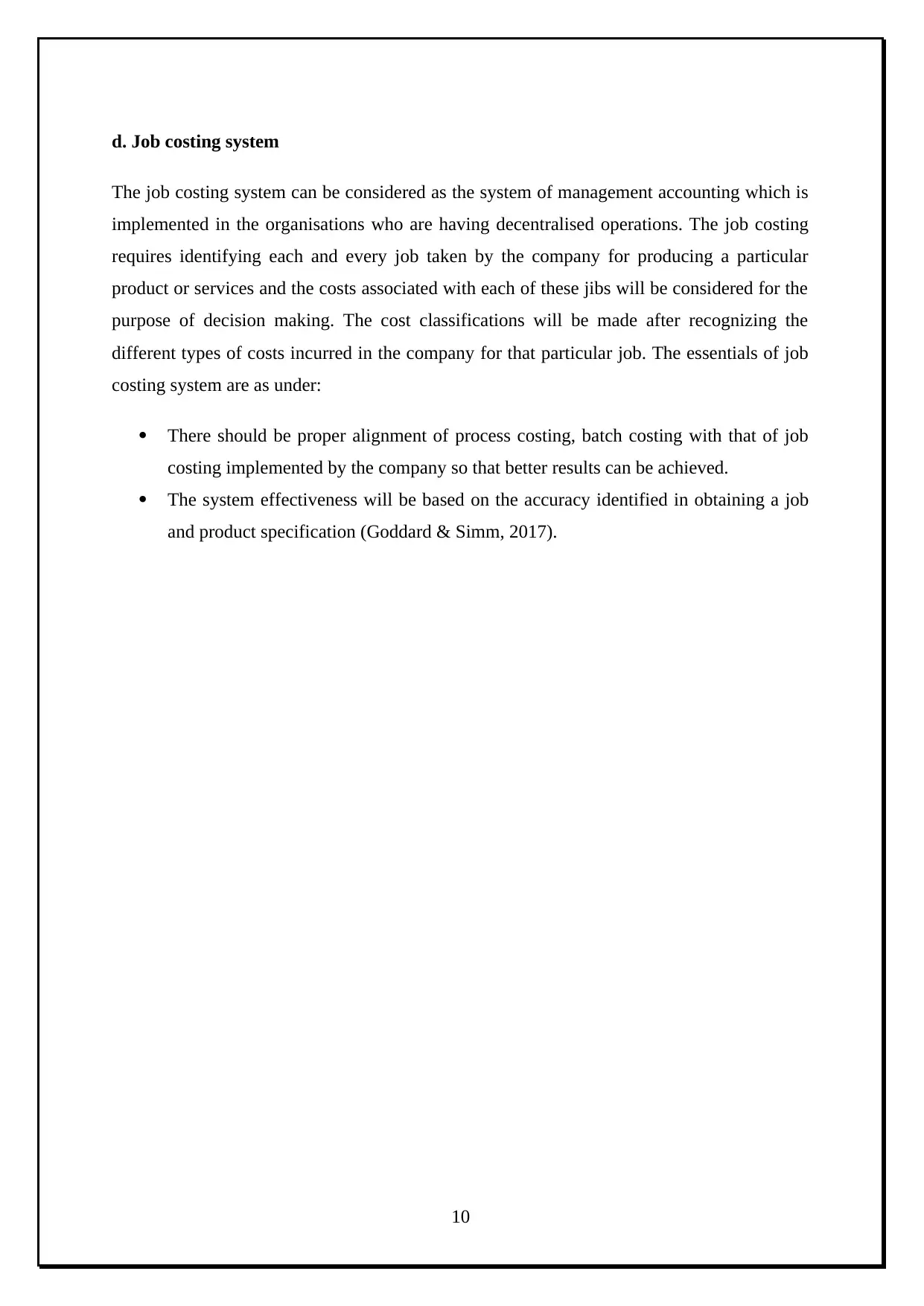
d. Job costing system
The job costing system can be considered as the system of management accounting which is
implemented in the organisations who are having decentralised operations. The job costing
requires identifying each and every job taken by the company for producing a particular
product or services and the costs associated with each of these jibs will be considered for the
purpose of decision making. The cost classifications will be made after recognizing the
different types of costs incurred in the company for that particular job. The essentials of job
costing system are as under:
There should be proper alignment of process costing, batch costing with that of job
costing implemented by the company so that better results can be achieved.
The system effectiveness will be based on the accuracy identified in obtaining a job
and product specification (Goddard & Simm, 2017).
10
The job costing system can be considered as the system of management accounting which is
implemented in the organisations who are having decentralised operations. The job costing
requires identifying each and every job taken by the company for producing a particular
product or services and the costs associated with each of these jibs will be considered for the
purpose of decision making. The cost classifications will be made after recognizing the
different types of costs incurred in the company for that particular job. The essentials of job
costing system are as under:
There should be proper alignment of process costing, batch costing with that of job
costing implemented by the company so that better results can be achieved.
The system effectiveness will be based on the accuracy identified in obtaining a job
and product specification (Goddard & Simm, 2017).
10
Paraphrase This Document
Need a fresh take? Get an instant paraphrase of this document with our AI Paraphraser
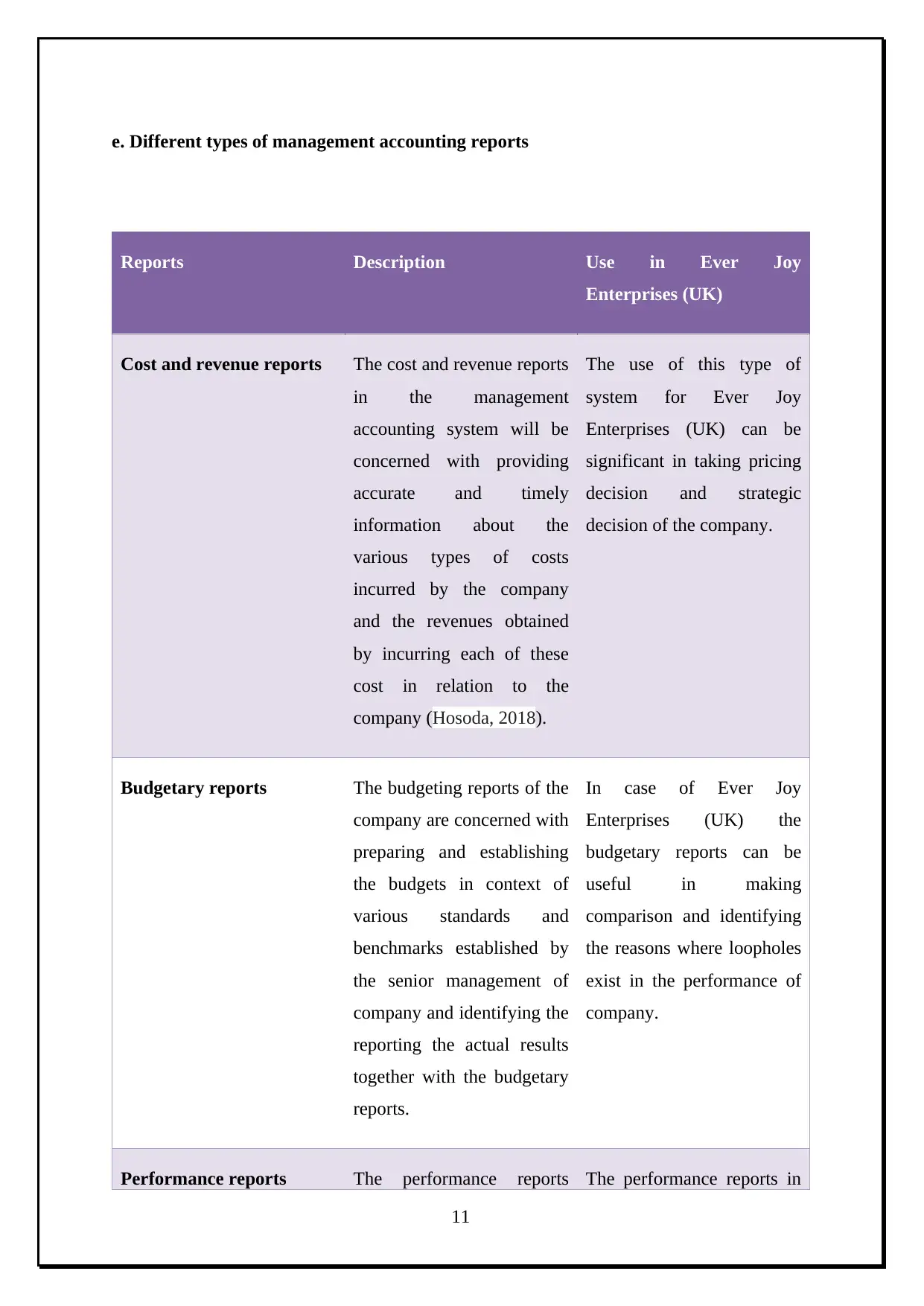
e. Different types of management accounting reports
Reports Description Use in Ever Joy
Enterprises (UK)
Cost and revenue reports The cost and revenue reports
in the management
accounting system will be
concerned with providing
accurate and timely
information about the
various types of costs
incurred by the company
and the revenues obtained
by incurring each of these
cost in relation to the
company (Hosoda, 2018).
The use of this type of
system for Ever Joy
Enterprises (UK) can be
significant in taking pricing
decision and strategic
decision of the company.
Budgetary reports The budgeting reports of the
company are concerned with
preparing and establishing
the budgets in context of
various standards and
benchmarks established by
the senior management of
company and identifying the
reporting the actual results
together with the budgetary
reports.
In case of Ever Joy
Enterprises (UK) the
budgetary reports can be
useful in making
comparison and identifying
the reasons where loopholes
exist in the performance of
company.
Performance reports The performance reports The performance reports in
11
Reports Description Use in Ever Joy
Enterprises (UK)
Cost and revenue reports The cost and revenue reports
in the management
accounting system will be
concerned with providing
accurate and timely
information about the
various types of costs
incurred by the company
and the revenues obtained
by incurring each of these
cost in relation to the
company (Hosoda, 2018).
The use of this type of
system for Ever Joy
Enterprises (UK) can be
significant in taking pricing
decision and strategic
decision of the company.
Budgetary reports The budgeting reports of the
company are concerned with
preparing and establishing
the budgets in context of
various standards and
benchmarks established by
the senior management of
company and identifying the
reporting the actual results
together with the budgetary
reports.
In case of Ever Joy
Enterprises (UK) the
budgetary reports can be
useful in making
comparison and identifying
the reasons where loopholes
exist in the performance of
company.
Performance reports The performance reports The performance reports in
11
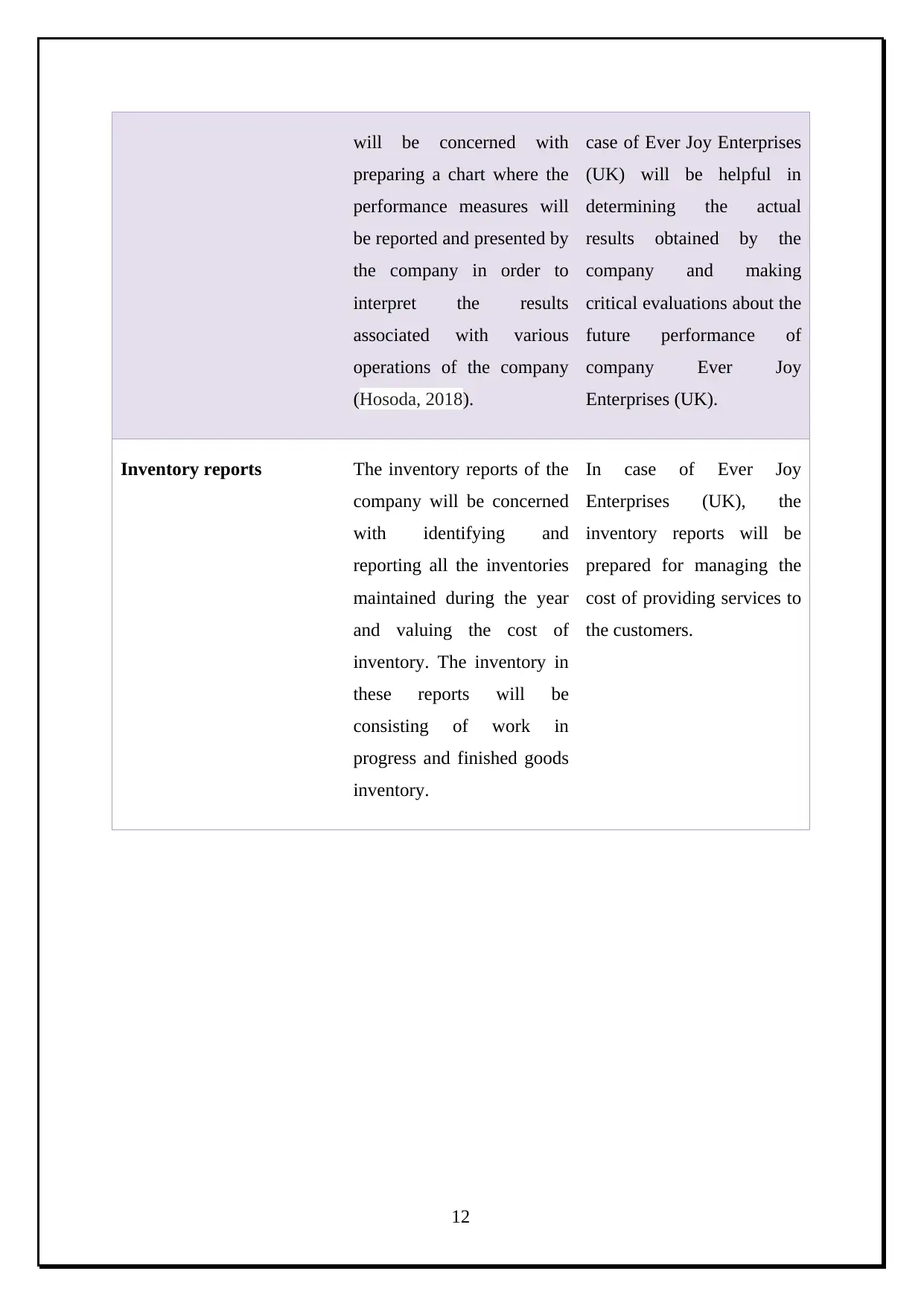
will be concerned with
preparing a chart where the
performance measures will
be reported and presented by
the company in order to
interpret the results
associated with various
operations of the company
(Hosoda, 2018).
case of Ever Joy Enterprises
(UK) will be helpful in
determining the actual
results obtained by the
company and making
critical evaluations about the
future performance of
company Ever Joy
Enterprises (UK).
Inventory reports The inventory reports of the
company will be concerned
with identifying and
reporting all the inventories
maintained during the year
and valuing the cost of
inventory. The inventory in
these reports will be
consisting of work in
progress and finished goods
inventory.
In case of Ever Joy
Enterprises (UK), the
inventory reports will be
prepared for managing the
cost of providing services to
the customers.
12
preparing a chart where the
performance measures will
be reported and presented by
the company in order to
interpret the results
associated with various
operations of the company
(Hosoda, 2018).
case of Ever Joy Enterprises
(UK) will be helpful in
determining the actual
results obtained by the
company and making
critical evaluations about the
future performance of
company Ever Joy
Enterprises (UK).
Inventory reports The inventory reports of the
company will be concerned
with identifying and
reporting all the inventories
maintained during the year
and valuing the cost of
inventory. The inventory in
these reports will be
consisting of work in
progress and finished goods
inventory.
In case of Ever Joy
Enterprises (UK), the
inventory reports will be
prepared for managing the
cost of providing services to
the customers.
12
⊘ This is a preview!⊘
Do you want full access?
Subscribe today to unlock all pages.

Trusted by 1+ million students worldwide
1 out of 24
Related Documents
Your All-in-One AI-Powered Toolkit for Academic Success.
+13062052269
info@desklib.com
Available 24*7 on WhatsApp / Email
![[object Object]](/_next/static/media/star-bottom.7253800d.svg)
Unlock your academic potential
Copyright © 2020–2025 A2Z Services. All Rights Reserved. Developed and managed by ZUCOL.





